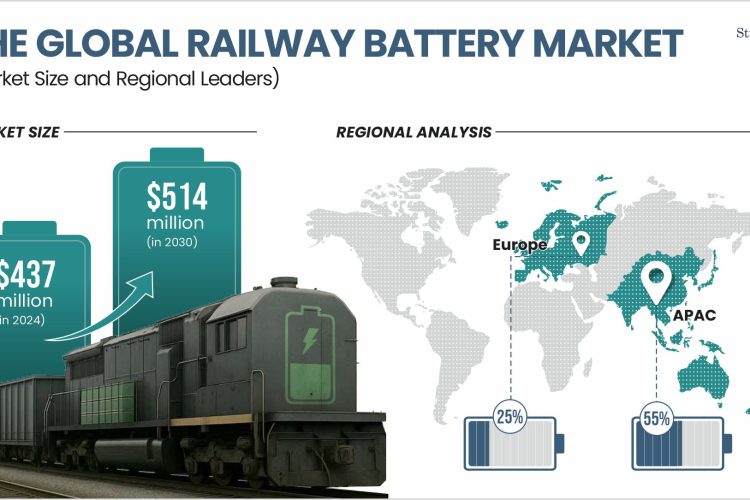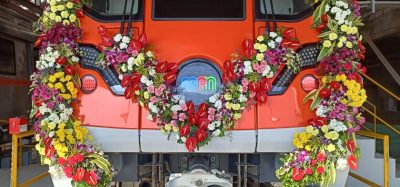Battery technology gains ground in the race to decarbonise rail
Posted: 13 August 2025 | Chandana Patnaik | No comments yet
Railway batteries are transforming transport by reducing diesel use, supporting hybrid and electric trains, and enabling cost-effective electrification across global rail networks.


Credit: Stratview Research
For centuries, trains have been dependent on diesel engines and electrified overhead lines to move. The entire rail industry has seen a lot of developments over the years. Something that remains vital amongst all advancements is the usage of power source – batteries.
In recent years, the demand for railway batteries has picked up a remarkable pace. The global market value was worth $437 million in 2024 and is projected to cross $514 million by 2030. This growth shows how the industry is steadily moving on the track of electrification and modern energy technologies.
The chemistry behind rail batteries
Rail batteries are designed to be used under the most demanding environments and hence, material selection or, say, battery type becomes the most vital decision to make.
Lead-acid batteries are considered the oldest rechargeable batteries ever in existence. In railways, all the three major battery types are used: Lead, Ni-Cad and Lithium, but in varied degrees.
However, even if different chemistries appear, lead-acid batteries win out in rail services. Despite their weight and low energy density (especially when compared to lithium-ion batteries), they are widely used because of their ability to deliver steady aux-power under tough conditions, their low cost, and, mostly, their decades of proven reliability.
Over the past decade, lead-acid batteries have consistently dominated, accounting for over 40% of the total rail-battery market. This trend continues in 2024 and 2025, where their market share remains above 45%, and forecasts indicate they will continue to maintain their lead position into the future. Within lead-acid technology, three main types exist: Flooded, Gel, and AGM (Absorbent Glass Mat). AGM type lead-acid batteries are used in over 50% of cases for their robust design, vibration resistance, and maintenance-free operation, offering critical advantages like spill-proofing, high current output, and fast charging in the demanding railway environment.
With a market share close to lead-acid batteries, Nickel-Cadmium (Ni-Cd) batteries continue to be the second most favoured choice in railway applications, owing to their power density, longer life and their resilience in extreme temperatures. These properties also make them favourable for high-speed trains like metros and other hybrid/electric trains.
While Lithium technology is gaining traction across various applications, including E-vehicles, household devices, etc., it has yet to see widespread adoption in the rail industry. Their adoption in rail will remain slow-paced due to their higher costs and integration challenges.
Why batteries? Why now?
Governments across the globe are charting the course towards green initiatives. Rail batteries are one among all those measures taken. Rail, already considered a low-carbon way to commute (compared to cars, buses, etc.), becomes even more environmentally friendly with the integration of rail batteries, which enhance their potential by reducing the need for diesel traction and supporting the shift towards full or partial electrification.
Batteries offer a way forward. They bridge the gaps in electrification, eliminate the need for costly infrastructure while delivering immediate operational and environmental benefits. The prices of installing overhead rail wire, or catenary, fall anywhere between £1.5 to 2 million per kilometre. Obviously, the longer the route, the higher the installation costs.
Batteries do not require extensive installation of overhead wires or substations. Instead, their costs are usually associated with the battery packs, onboard charging systems, and periodic charging infrastructure at depots or selected stops.
As of now, less than 40% of global rail lines are electrified, leaving many segments diesel-operated, and this pace of electrification is growing rapidly, with many countries across the globe heavily investing in battery technology for rail advancements. This thus increases requirements for high-performance batteries to power hybrid or fully electric trains.
Regions on track for a battery-powered future
While precise global rankings may vary by source, most analyses identify the top five countries investing in railway battery traction infrastructure as China, the United States, Germany, Japan, and India. Notably, three of these are major Asia-Pacific (APAC) economies, with China and India being two of the world’s largest and fastest-growing rail networks.
According to Stratview Research, the APAC region commands a dominant position in the rail battery market, accounting for more than 50% of the global share, since countries including Japan, China, and India are leveraging battery innovations in their rail tracks, having their governments supporting infrastructure upgrades. These countries are also setting global benchmarks in decarbonising non-electrified rail networks.
For instance, Japan’s BEC819 Electric Multiple Units (EMUs), China’s 1,000 kW locomotives (rolled out in April 2025), India’s 2030 full electrification target with pilot battery trains, and South Korea’s battery-powered commuter projects reflect APAC’s strong push to decarbonise non-electrified rail networks.
Talking about decarbonisation, regardless of industry, would be incomplete without Europe’s contribution. Germany’s deployment of FLIRT Akku battery EMUs, piloting of battery-powered Transport Express Regional (TER) units in France, etc., prove Europe’s decisive moves to eliminate diesel traction. Europe, hence, stands second in the global railway battery market, right after APAC.
The last mile is electric
In the future, as global rail networks shift towards cleaner propulsion, battery-powered trains will become a strategic asset. Railway batteries are and will be playing a critical role, not only in starting diesel engines but also in supporting key onboard systems in hybrid and electric trains. With sustainability driving rail innovation, the global railway battery market is projected to grow at over 6% CAGR in the coming years, reinforcing its central role in the future of rail transport.
About the Author
Chandana Patnaik is an experienced technical writer, presently serving as a Senior Content Writer at Stratview Research. She has carved her niche in specific areas including disruptive technologies, information, and technologies. etc.
She is a regular contributor to various magazines and blogs and writes insightful content that keeps readers stay up-to-date with the latest trends and developments in her areas of expertise.
Stay Connected with Global Railway Review — Subscribe for Free!
Get exclusive access to the latest rail industry insights from Global Railway Review — all tailored to your interests.
✅ Expert-Led Webinars – Gain insights from global industry leaders
✅ Weekly News & Reports – Rail project updates, thought leadership, and exclusive interviews
✅ Partner Innovations – Discover cutting-edge rail technologies
✅ Print/Digital Magazine – Enjoy two in-depth issues per year, packed with expert content
Choose the updates that matter most to you. Sign up now to stay informed, inspired, and connected — all for free!
Thank you for being part of our community. Let’s keep shaping the future of rail together!
Related topics
Digitalisation, Electric/Hybrid Rolling Stock, Electrification & Cabling, Infrastructure Developments, Passenger Experience/Satisfaction, Rolling Stock Orders/Developments, Signalling, Control & Communications, Sustainability/Decarbonisation, Technology & Software








